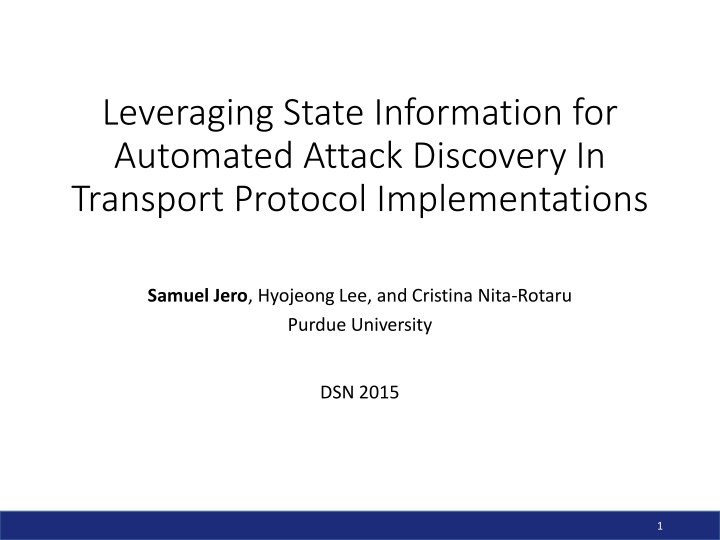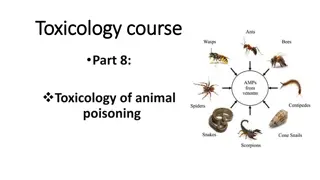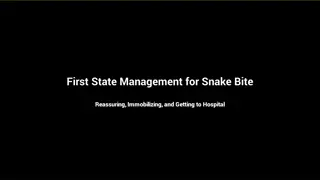
Leveraging State Information for Automated Attack Discovery in Transport Protocols
Explore the challenges in detecting attacks in transport protocol implementations, uncovering the reasons behind the multitude of attacks, and discovering current testing methods, with a focus on the SNAKE approach for network attack exploration.
Download Presentation

Please find below an Image/Link to download the presentation.
The content on the website is provided AS IS for your information and personal use only. It may not be sold, licensed, or shared on other websites without obtaining consent from the author. If you encounter any issues during the download, it is possible that the publisher has removed the file from their server.
You are allowed to download the files provided on this website for personal or commercial use, subject to the condition that they are used lawfully. All files are the property of their respective owners.
The content on the website is provided AS IS for your information and personal use only. It may not be sold, licensed, or shared on other websites without obtaining consent from the author.
E N D
Presentation Transcript
Leveraging State Information for Automated Attack Discovery In Transport Protocol Implementations Samuel Jero, Hyojeong Lee, and Cristina Nita-Rotaru Purdue University DSN 2015 1
Transport Protocols Critical to today s Internet Used by many applications Underlie secure protocols like TLS Underlie network infrastructure protocols like BGP Numerous implementations Over 3,000 implementation variants detectable by nmap 2
Why So Many Attacks? Many designs and implementations Multiple variations, especially of congestion control Tahoe, Reno, New Reno, SACK, Vegas, BIC, CUBIC, others Over 20 RFCs defining variations or features Hundreds of implementations Complex goals Reliability, in-order delivery, congestion control, others Written in low level languages, part of OS Error-prone, but highly efficient Heavily optimized Prefer performance to ease of understanding and maintenance 4
Current Testing Methods Developer test suites Tests used by developer to make sure implementation is correct Packetdrill [USENIX 13] Fuzzing KiF [IPTComm 07], SNOOZE [ISC 06], EXT-NSFM [IMCCC 11] Find crashes by subjecting implementation to random inputs MAX [SIGCOMM 11] Automatically find manipulation attacks using symbolic execution Turret [ICDCS 14] Find performance attacks on distributed systems using greedy message modification protocols Ad-hoc, focused on benign scenarios Unable to cover entire protocol, difficulty reaching deep states Requires the user to select vulnerable lines of code Only focused on performance attacks, difficulty with transport 5
Our Approach SNAKE: State-based Network AttacK Explorer Tests unmodified implementations Uses message-based attacks Finds performance, fairness, and resource exhaustion attacks Uses protocol state machine to enable efficient, systematic testing Found 5 new and 4 known attacks 5 protocol implementations 2 protocols 4 operating systems 6
Outline Motivation Transport Protocols SNAKE: Design and Implementation Evaluation and Results Summary 7
Transport Protocols Responsible for end-to-end communication Provide guarantees to applications Reliability In-order delivery Flow control Congestion control Fairness Connection oriented to maintain state Connection establishment Data transfer Connection tear down There are more than 13 RFCs dealing with TCP Congestion Control alone! 8
Attacker Model Malicious Clients Off-path Attackers Connection establishment attacks Throughput degradation attacks Resource exhaustion attacks Fairness attacks 9
TCP CLOSE_WAIT Resource Exhaustion Attack Client can force server to keep socket state around for 13-30 minutes Client application exits Client responds to all future data with Resets Resets are dropped Server must receive ACKs for all data before it can close connection 10
How Do We Find Attacks? Attack injection scheme Identify points where message-based attacks could be inserted into a test scenario Impacts the practicality and effectiveness of the testing Practicality: Systematic, exhaustive testing should test all attack injection points Effectiveness: Testing can only find vulnerabilities that occur at attack injection points 11
Packet-Send-based Attack Injection For each packet, inject each message attack at packet send Pros Simple Systematic Cons Does not support injecting new packets No support for off-path attacks Only considers modifying a single packet per test Not Scalable! Scales with packets * attacks Our two minute TCP tests generate about 13,000 packets 13,000 pkts * 53 attacks * 2 min = 22,967 hours = 956 days Misses Attacks! Unable to find off-path attacks 12
Time-based Attack Injection Every n seconds, inject each message attack and observe the result n represents a trade off between scalability and coverage Minimum n is the time to transmit a minimum sized packet Pros Supports injecting new packets Cons Only considers applying a single attack per test transmit at 100Mbits/sec Cannot Achieve Scalability and Coverage! Scales with n*connection_length*attacks A minimum sized TCP packet takes 5 microseconds to 12 million pkts*60 attacks*2min = 24 million hours 13
Protocol State Machine Attack Injection Improved scalability and coverage State machine identifies key protocol areas Similar packet types received in the same state often perform similar actions Combine protocol state and packet type for attack injection TCP State Machine 14
Protocol State Machine Attack Injection Consider the protocol state, packet type pairs and apply each message attack to each pair Pros Scalable---About 300 hours to test an implementation Can apply attacks to more than a single packet Cons Assumes state machine is available Assumes state machine is implemented correctly 15
SNAKE Virtual machines running unmodified implementations with an emulated network A malicious proxy in front of one VM performs attack injection Supported message attacks: Drop, Duplicate, Delay, Batch, Reflect, Lie about packet fields, Inject, and HitSeqWindow Current protocol state tracked by monitoring packets 16
SNAKE During testing, performance and resource usage information is collected to identify attacks Attack declared successful if: Throughput of a flow is above or below that of the competing flow s by more than a factor of 2 Server resources are not released at the end of the test 17
Evaluation Two transport protocols TCP DCCP Strategies tested: TCP: 5,500 DCCP: 4,500 Five implementations in four operating systems: Linux 3.0/Linux 3.13 Windows 95/Windows 8.1 Testing time per implementation: About 60 hours Found 9 vulnerabilities, 5 of them unknown 18
Results Summary Protocol Attack Impact OS Known TCP CLOSE_WAIT Resource Exhaustion Server DoS Linux 3.0/3.13 Partially TCP Packets with Invalid Flags Fingerprinting Linux 3.0 / Win 8.1 No TCP Duplicate Ack Spoofing Poor Fairness Win 95 Yes TCP Reset Attack Client DoS All Yes TCP SYN-Reset Attack Client DoS All Yes TCP Duplicate Ack Rate Limiting Degraded Throughput Win 8.1 No DCCP Ack Mung Resource Exhaustion Server DoS Linux 3.13 No DCCP In-window Ack Sequence Number Modification Degraded Throughput Linux 3.13 No DCCP REQUEST Connection Termination Client DoS Linux 3.13 No 19
Summary We propose a new, efficient technique for automated, systematic testing of transport protocol implementations based on the protocol s state machine We have implemented this technique in SNAKE and applied it to 5 implementations of 2 transport protocols in 4 operating systems We found 9 attacks, 5 of which are unknown 20
Questions? 21




















